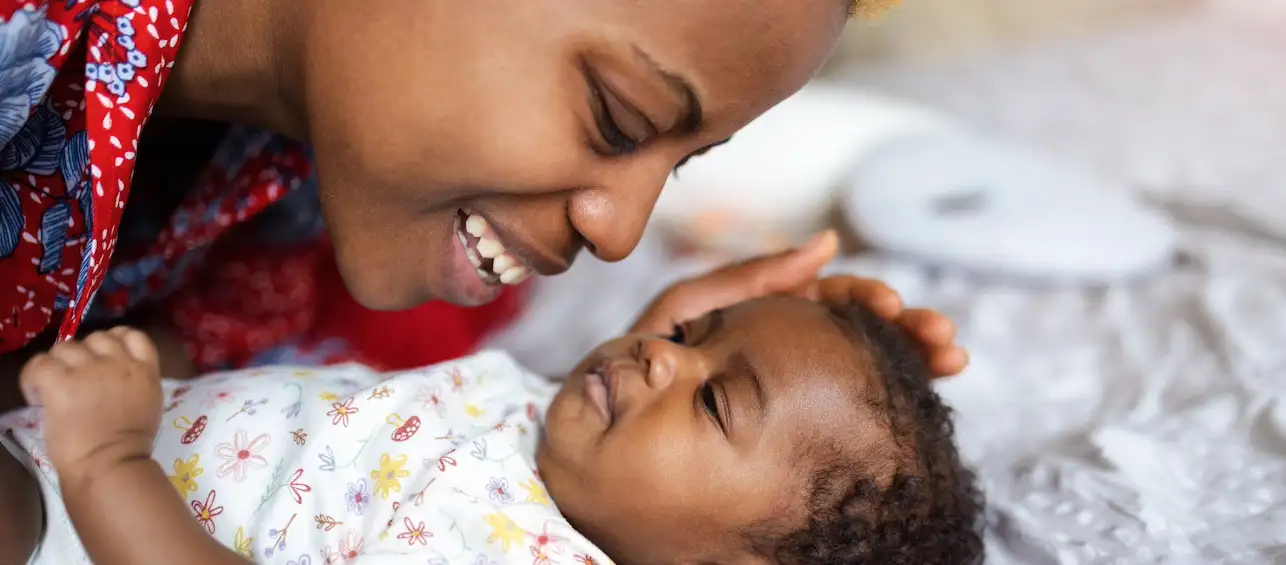As a new parent, it can be overwhelming sorting through all of the advice you receive. The one you’ve probably heard the most is to put your baby on his back to sleep, to help prevent sudden infant death syndrome (SIDS). While this is sound advice and parents should continue doing it, there is a second part to that recommendation: put baby on his or her tummy to play. This helps to strengthen baby’s muscles and help prevent common infantile conditions like plagiocephaly and torticollis.
Plagiocephaly, the flattening on the back of the head on one side, and torticollis often happen together. Torticollis occurs when there is shortening and tightness of a major muscle on one side of the neck, called the sternocleidomastoid (SCM). The function of this muscle is to tilt and turn the head. With torticollis, one side of the SCM is tight and stronger, while the SCM on the other side of the neck is weaker. This can cause a baby’s head to tilt and turn to one side only.
If your baby has been diagnosed with infantile torticollis, you may be understandably worried. But the good news is that with early intervention, torticollis can be corrected. In fact, if physical therapy is started before one month of age, 98% of infants can achieve a near normal range of movement within 1.5 months. This is why awareness is important! If you know what signs to look for, you can bring it up to your doctor sooner.
5 Must-Know Points About Infantile Torticollis
1. The Risk Factors
There are a few factors that put a baby at a higher risk for developing torticollis: having a body length longer than 20.2 in at birth; being the first born; having facial or head asymmetry; and the utilization of forceps or suction devices during birth. Babies who do not receive enough tummy time, or lay in a positioning device for a long amount of time, are also at greater risk of developing plagiocephaly. Young babies typically don’t have enough strength to hold their head straight up when in positioners, such as swings and bouncy seats; instead, their head tilts to one side.
2. Signs to watch for
If you see your baby using one hand over the other, something’s not right. Children should not be favoring a hand until many years later! This could mean that she has had muscle shortening on one side of her body. Or, if you notice that your baby has difficulty breastfeeding on one side versus the other, this could be a sign of torticollis. Similarly, another symptom is if your baby tends to tilt his head to one side, or prefers to look in one direction.
3. The importance of early intervention
There used to be a “wait and see” approach with torticollis, but there is now a lot of evidence to support early intervention. In fact, waiting until after one month of age prolongs the length of physical therapy needed to about six months. And waiting until after six months can require 9-10 months of physical therapy, with progressively fewer infants achieving a near normal range. Further, infants are more cooperative with treatment before two months of age, when they don’t have a lot of head control. Early intervention does require parents to keep an eye out for the signs, as a lot can happen in between those well check visits.
4. Screen for other conditions
If your baby is diagnosed with torticollis, it’s important to rule out other conditions that may be affecting how your child positions his head. We will screen for orthopedic, neurological and vision problems. In addition, we will look for other diagnoses that may be present with torticollis, including plagiocephaly, hip dysplasia, a brachial plexus injury, and early motor delays.
5. Prevention methods
Here are a few ways to help prevent torticollis:
- Provide supervised tummy time while baby is awake, at least 15-30 minutes total each day by two months. This will strengthen her neck, arms, tummy and back muscles.
- Change your baby’s position often when she is awake.
- Limit the amount of time your baby rests in positioning devices, like car seats, bouncy chairs, baby swings and strollers.
- Look for the signs and symptoms discussed in section #2, such as asymmetry and postural preferences. Photographs are a great way to get a more objective view. Please do not hesitate to contact your pediatrician if you notice something concerning!
To learn more about our Congenital Muscular Torticollis Program, or our division of Occupational and Physical Therapy, please call 513-636-4651 or email at otpt@cchmc.org.






Tummy time is definitely important. No problem with my daughter but my son hated it and it was very stressful in the early weeks. I felt encouraged when I read about doing it in your chest or that even holding them up on your shoulder in like burp position helps. I gave up on traditional tummy time for a few weeks and focused on those sneaky ways and when we went back to regular tummy time he didn’t have any issues with it. Having a newborn is tough enough tips for how to help baby strengthen and use muscles outside of the traditional tummy time would be a good post because no one wants to make their new babe wail.